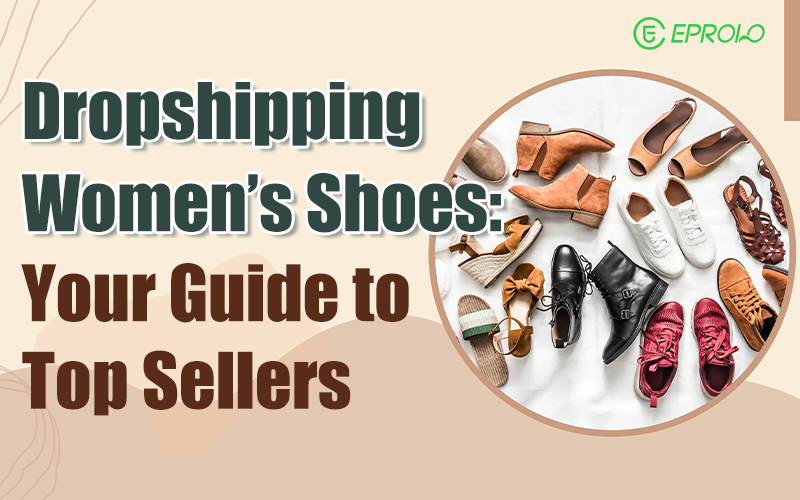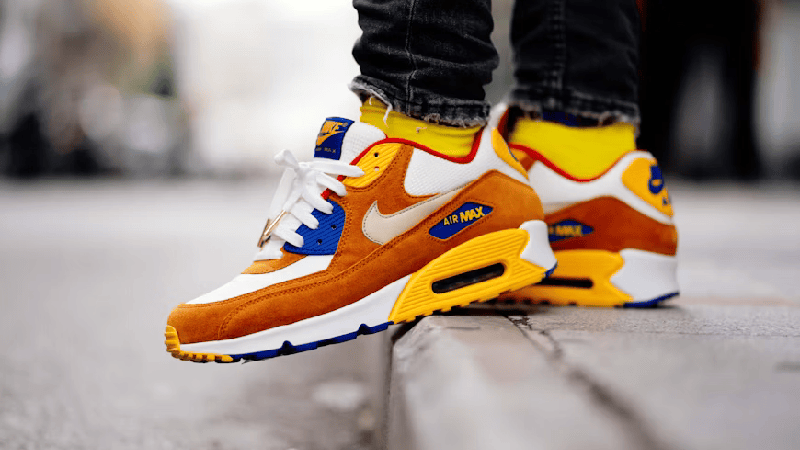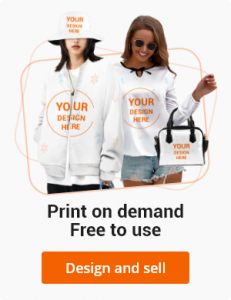The global footwear industry is growing rapidly, and women’s shoes make up the largest chunk of that pie. Whether it’s sneakers, sandals, boots, or heels, women buy more styles, shop more often, and care deeply about both comfort and design. That’s exactly why women’s shoes are a goldmine for dropshipping, if you do it right.
Let’s walk through how to spot winning products, choose the right suppliers, and build a store that converts browsers into loyal buyers.

Page overview:
Why Women’s Shoes Are Dropshipping Gold
Top Product Types That Actually Sell (with Data-Backed Detail)
How to Spot Winning Shoes Before Everyone Else
Choosing the Right Supplier (This Part Matters More Than You Think)
Why EPROLO Is Built for Shoe Dropshippers
How to Price for Profit (Without Scaring Customers Off)
Reduce Returns with Better Product Pages
Build for Long-Term Success, Not Quick Wins
Why Women’s Shoes Are Dropshipping Gold
Shoes are a need. Women don’t buy just one or two pairs a year. They buy for work, weekends, events, and seasons. Think about it:
- Boots in the fall
- Sandals in summer
- Heels for weddings
- Sneakers for everything else
Plus, with trends like athleisure and comfort-first fashion, shoppers are on the hunt for footwear that looks good and feels better. According to surveys, 95% of women prioritize comfort, but that doesn’t mean style takes a back seat. They want both. That opens up multiple pricing tiers, customer types, and niches you can sell into, without holding inventory yourself.
Top Product Types That Actually Sell (with Data-Backed Detail)
1. Everyday Sneakers
These are your evergreen bestsellers: women love versatile sneakers that go from the school run to a coffee meet-up.
Why they fly:
- Women want sneakers that are both stylish and comfortable, something they can wear all day without foot pain.
- Breathable materials and cushioned soles are no longer a bonus—they’re expected.
- The rise of athleisure means many women wear sneakers not just for workouts, but for daily errands, casual outings, and even work.
- More shoppers now prioritize comfort over fashion, but the right sneakers give them both.
Product checklist:
- Breathable mesh or lightweight textile uppers.
- Soft padded insoles or memory foam.
- Neutral colorways (white, black, nude).
- Marketing hooks: “Run school drop-off, run errands, feel good all day”.
Best selling windows:
- January (new fitness routines)
- August (back-to-school time)
2. Work-Ready Flats & Low Heels
Need office-ready shoes that won’t kill your feet by 3 pm? This is your sweet spot.
Market appeal: Flats with good arch support are in high demand because women want comfort that lasts through a full workday. Many are no longer willing to choose between style and support—they want both. That’s why polished, comfortable flats and low heels have become everyday staples. Once shoppers find a pair that looks good and feels even better, they tend to stick with that style or brand.
Product checklist:
- Arch support + padded insoles.
- Grippy or non-slip soles.
- Classic, polished colors: black, nude, navy.
- Clean textures (faux suede, soft leather).
- Marketing: “Office-ready flats that feel like sneakers”.
3. Seasonal Staples: Boots & Sandals
As the calendar flips, so should your catalog. Seasonal launches earn attention—and conversions.
Fall/Winter picks:
- Ankle or mid-calf boots with side zippers are easy to fit and sell well.
Spring/Summer picks:
- Sandals with adjustable straps, espadrilles, slides—popular and functional.
Why they convert:
- Seasonal patterns are predictable—people set their minds on weather-appropriate footwear.
- Smartly timed launches (early Q1 for sandals, late Q3 for boots) give you a marketing edge.
Product checklist:
- Boot style: mid-calf, zipper, waterproof lining.
- Sandal features: cushioned footbed, adjustable closure.
- Hook: “Your go-to [boots/sandals] for this season”.
4. Special Occasion Shoes
Weddings, vacations, date nights: these are event-driven buying. People are ready to spend more.
What sells:
- Block heels, wedding flats, metallic sandals built to last through an event.
Market insights: Although price is often a barrier in everyday footwear, special occasion shoes are a different story. For weddings, vacations, and milestone events, buyers are usually more willing to invest in the right pair, both for comfort and style. These purchases are more emotional and intentional, which also leads to lower return rates.
Product checklist:
- Heels under 3″ with arch/cushion support.
- Varied textures: metallic, suede, satin.
- Use-time proof: mention comfort for receptions/dances.
- Marketing angle: “Stylish and comfy for your big day.”

Recap Table
| Category | Core Benefits | Hot Features | Selling Angle |
|---|---|---|---|
| Everyday Sneakers | Comfort + style for any day | Mesh uppers, cushioned soles | “Daily sneakers for school runs & brunch” |
| Work Flats & Low Heels | Dressy but comfortable all day | Arch support, padded insoles, non-slip | “Office shoes that won’t hurt your feet” |
| Seasonal Staples | Trend-oriented, seasonal relevance | Zippers for boots, straps for sandals | “Gear up for summer” / “Cozy fall boots” |
| Special Occasion Shoes | Higher price, event-ready, low returns | Block heels, metallic accents | “Wedding-ready heels that stay comfy” |
How to Spot Winning Shoes Before Everyone Else
Selling what people actually want is key. Here’s how to find those winners:
- Use Keyword Tools: Search terms like “best shoes for nurses” or “wide fit flats” show what people are Googling right now.
- Check Marketplaces: Amazon bestsellers and review sections are gold. Look for comfort complaints and feature praise.
- Follow Social Trends: TikTok, Pinterest, and Instagram will show you what’s going viral. Save high-engagement posts for product inspo.
- Test & Track: Start with a small catalog (15–20 styles), then double down on what gets traffic and clicks.
Choosing the Right Supplier (This Part Matters More Than You Think)
Shoes aren’t one-size-fits-all. If your supplier gets sizing or quality wrong, you’ll pay for it in returns and bad reviews.
Here’s what to look for:
- Sizing Consistency: Ask for detailed size charts. Compare to standard US sizing. Better yet, order samples and try them.
- Material Transparency: Your listings should match the product exactly. If it’s faux leather or a textile blend, say so. Customers can tell.
- Quality Construction: Look at stitching, glue marks, sole strength, and interior padding. If your supplier can’t provide close-up photos, skip them.
- Support and Service: Fast response times, real communication, and a clear return policy = a supplier you can trust.
Why EPROLO Is Built for Shoe Dropshippers
EPROLO checks all the right boxes, especially for shoes:
- Global Warehouse Network: Fast, local shipping = happier customers and fewer “where’s my order?” messages.
- Branding & POD Tools: Add your logo to tags and boxes. Want your own colors? EPROLO’s product customization tools make that possible, without big upfront costs.
- Shopify & WooCommerce Integration: Your orders sync automatically. No manual work. Just more time to market and scale.
How to Price for Profit (Without Scaring Customers Off)
Each shoe category has its own sweet spot:
| Segment | Retail Price | Best For |
|---|---|---|
| Budget | $20–$40 | Basic flats, seasonal sandals |
| Mid-Range | $40–$80 | Daily wear, office shoes, sneakers |
| Premium | $80+ | Events, bridal, fashion-forward buyers |
Aim for 40–60% margins after shipping and platform fees. In mid-range, you’ll get a good balance of volume and value.
Marketing That Moves Pairs
Here’s how to market dropshipping for women’s footwear:
- “Finally, shoes that don’t hurt after 8 hours.” Talk about real problems. Comfort sells.
- Lifestyle visuals: Show women wearing the shoes in real settings. Less studio white space, more brunch, walking, and commuting.
- Social proof: Share reviews, try-on videos, or UGC. People trust people, not just polished photos.
- Seasonal urgency: “Boots before the chill hits” or “Last weekend for spring sandals” creates timely motivation.
Reduce Returns with Better Product Pages
Returns eat your profit. But most can be avoided if you:
- Include clear size charts with foot length in inches/cm.
- Use multiple photos: front, side, sole, close-up.
- Explain comfort features in plain language (“soft arch support” beats “orthopedic foam”).
- Show real-life wear (e.g., a model walking, sitting, standing).
Build for Long-Term Success, Not Quick Wins
One happy shoe buyer = three future purchases. Here’s how to build loyalty:
- Track feedback: Look for patterns in returns and reviews.
- Launch seasonal collections: Announce boots in October, sandals in March.
- Use email or SMS: “Loved those sneakers? Here’s a flat you’ll wear to work.”
Women shop repeat brands for shoes once they trust fit and feel. Be that brand.
Getting Started: Your First 3 Steps
- Choose 15–20 styles across flats, sneakers, sandals, and boots.
- Order samples to test fit, comfort, and photos.
- Build real product pages with sizing info, lifestyle pics, and benefit-focused descriptions.
Then start testing. Focus on one core niche at first (like workwear or casual). Build your audience, then expand.
Final Thought
Women’s shoes are one of the most profitable, high-potential categories in dropshipping, but only for sellers who respect the category. Don’t chase shiny trends. Deliver shoes that fit, feel good, and show up on time.
Do that, and you’re building a brand she’ll come back to.







